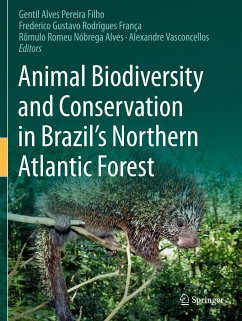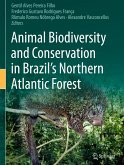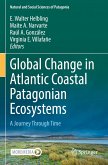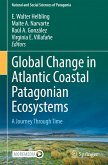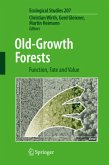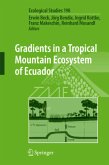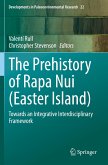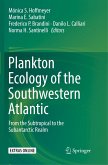Animal Biodiversity and Conservation in Brazil's Northern Atlantic Forest
Herausgegeben:Pereira Filho, Gentil Alves; França, Frederico Gustavo Rodrigues; Alves, Rômulo Romeu Nóbrega; Vasconcellos, Alexandre
Animal Biodiversity and Conservation in Brazil's Northern Atlantic Forest
Herausgegeben:Pereira Filho, Gentil Alves; França, Frederico Gustavo Rodrigues; Alves, Rômulo Romeu Nóbrega; Vasconcellos, Alexandre
- Broschiertes Buch
- Merkliste
- Auf die Merkliste
- Bewerten Bewerten
- Teilen
- Produkt teilen
- Produkterinnerung
- Produkterinnerung
This book describes the fauna of the Pernambuco Endemism Center in Brazil's Northern Atlantic Forest, an understudied global biodiversity hotspot. Through fifteen curated chapters, it provides the latest information about the fauna of the northern portion of the Atlantic Forest, gathering important information about the faunal composition of the region for the first time. The chapters address animal biodiversity including terrestrial and aquatic vertebrates (fish, amphibians, reptiles, birds, and mammals) and invertebrates (ants, butterflies, dung beetles, hervestmen, spiders, and termites).…mehr
Andere Kunden interessierten sich auch für
![Animal Biodiversity and Conservation in Brazil's Northern Atlantic Forest Animal Biodiversity and Conservation in Brazil's Northern Atlantic Forest]() Animal Biodiversity and Conservation in Brazil's Northern Atlantic Forest169,99 €
Animal Biodiversity and Conservation in Brazil's Northern Atlantic Forest169,99 €![Global Change in Atlantic Coastal Patagonian Ecosystems Global Change in Atlantic Coastal Patagonian Ecosystems]() Global Change in Atlantic Coastal Patagonian Ecosystems116,99 €
Global Change in Atlantic Coastal Patagonian Ecosystems116,99 €![Global Change in Atlantic Coastal Patagonian Ecosystems Global Change in Atlantic Coastal Patagonian Ecosystems]() Global Change in Atlantic Coastal Patagonian Ecosystems116,99 €
Global Change in Atlantic Coastal Patagonian Ecosystems116,99 €![Old-Growth Forests Old-Growth Forests]() Old-Growth Forests242,99 €
Old-Growth Forests242,99 €![Gradients in a Tropical Mountain Ecosystem of Ecuador Gradients in a Tropical Mountain Ecosystem of Ecuador]() Gradients in a Tropical Mountain Ecosystem of Ecuador223,99 €
Gradients in a Tropical Mountain Ecosystem of Ecuador223,99 €![The Prehistory of Rapa Nui (Easter Island) The Prehistory of Rapa Nui (Easter Island)]() The Prehistory of Rapa Nui (Easter Island)177,99 €
The Prehistory of Rapa Nui (Easter Island)177,99 €![Plankton Ecology of the Southwestern Atlantic Plankton Ecology of the Southwestern Atlantic]() Plankton Ecology of the Southwestern Atlantic177,99 €
Plankton Ecology of the Southwestern Atlantic177,99 €-
-
-
This book describes the fauna of the Pernambuco Endemism Center in Brazil's Northern Atlantic Forest, an understudied global biodiversity hotspot. Through fifteen curated chapters, it provides the latest information about the fauna of the northern portion of the Atlantic Forest, gathering important information about the faunal composition of the region for the first time. The chapters address animal biodiversity including terrestrial and aquatic vertebrates (fish, amphibians, reptiles, birds, and mammals) and invertebrates (ants, butterflies, dung beetles, hervestmen, spiders, and termites). All chapters provide species lists, taxonomic aspects and richness analysis. Conservation of specific animal groups is also discussed. Finally, the book discusses human impacts on the forest and its biodiversity, emphasizing the need for conservation of this highly impacted ecosystem.
Produktdetails
- Produktdetails
- Verlag: Springer / Springer International Publishing / Springer, Berlin
- Artikelnr. des Verlages: 978-3-031-21289-5
- 2023
- Seitenzahl: 292
- Erscheinungstermin: 2. Mai 2024
- Englisch
- Abmessung: 279mm x 210mm x 16mm
- Gewicht: 718g
- ISBN-13: 9783031212895
- ISBN-10: 3031212894
- Artikelnr.: 70193026
- Herstellerkennzeichnung Die Herstellerinformationen sind derzeit nicht verfügbar.
- Verlag: Springer / Springer International Publishing / Springer, Berlin
- Artikelnr. des Verlages: 978-3-031-21289-5
- 2023
- Seitenzahl: 292
- Erscheinungstermin: 2. Mai 2024
- Englisch
- Abmessung: 279mm x 210mm x 16mm
- Gewicht: 718g
- ISBN-13: 9783031212895
- ISBN-10: 3031212894
- Artikelnr.: 70193026
- Herstellerkennzeichnung Die Herstellerinformationen sind derzeit nicht verfügbar.
Gentil Alves Pereira Filho is a biologist (Ph.D in Zoology, 2011) who has been dedicated to the study of snakes in the neotropical region specially in the Brazilian Atlantic Forest. His main interests are taxonomy and ecology of neotropical snakes. He has conducted researches in Northeastern Brazil focused on the distribution of the snakes of the Atlantic Forest for more than 15 years resulting in several published articles. Nowadays he is an associated research at the Federal University of Paraíba (UFPB) and coordinates projects about snake ecology in the Atlantic Forest. Frederico G.R. França is a biologist (Ph.D. in Ecology, 2008), associate professor at Federal University of Paraíba - UFPB, and coordinator of Ecology Postgraduate Course. His keen interest is snake ecology and conservation, and his areas of academic interest are population and community ecology, ecomorphology and conservation biology. He has conducting research about Brazilian herpetofauna, mainly in the Cerrado and the Atlantic Forest. Rômulo R.N. Alves is a biologist (Ph.D. in Zoology, 2006) with a keen interest in the connections between humans and animals. His areas of academic interest are ethnozoology and wildlife trade, uses and conservation. He has conducted ethnobiological research for the last twenty years, which focuses on ethnozoology, particularly on fisheries, hunting, and wildlife trade and uses. He coordinates projects on hunting and uses of wildlife in Brazil. In addition, he is one of the Editors-in-Chief of the journal Ethnobiology and Conservation and member of the Editorial Board of the Journal of Ethnobiology and Ethnomedicine. He also holds a Productivity scholarship provided by the National Council of Science and Technology (CNPq). Alexandre Vasconcellos has a PhD in Biological Sciences (Zoology) from the Federal University of Paraíba (UFPB), Brazil. He develops projects on termite ecology and biogeography, soil ecology and conservation biology in neotropical ecosystems. He is curator of the Isoptera Collection and Coordinator of the Termitology Laboratory (LabTermes-UFPB). He has a Productivity Scholarship in Research, supported by the Brazilian National Council for Scientific and Technological Development (CNPq).
Chapter 1. An Introduction to the knowledge of Animal Diversity and Conservation in the Most Threatened Forests of Brazil.- Chapter 2. Northern Atlantic Forest: Conservation status and perspectives.- Chapter 3. Ants (Hymenoptera: Formicidae) in the Pernambuco Endemism Center of the Brazilian Atlantic Forest.- Chapter 4. The Butterfly Fauna of the Northern Atlantic Forest.- Chapter 5. Dung beetles from the Atlantic Forest north of the São Francisco River: A synthesis of a fragile fauna.- Chapter 6. The most endemic taxon of an area of endemism: harvestmen (Opiliones) fauna of NAF and its contribution for biogeography and conservation.- Chapter 7. The Spider Fauna of the Northern Brazilian Atlantic Forest: effect of sampling bias on diversity patterns and conservation.- Chapter 8. Termites from the Northern Atlantic Forest, Brazil: Ecology and Conservation.- Chapter 9. Fishes from the Northern Atlantic Forest and their conservation.- Chapter 10. Species richness, distribution pattern andconservation of amphibians in the northern portion of the Brazilian Atlantic Forest.- Chapter 11. Composition, Species Richness and Conservation of the Reptiles of the Highly Threatened Northern Brazilian Atlantic Forest.- Chapter 12. Bird diversity and conservation of the Northern Atlantic Forest.- Chapter 13. Mammals of the Pernambuco Endemism Center: diversity, biogeography, research gaps, and conservation concerns.- Chapter 14. Fisheries and uses of coastal aquatic fauna in the Northernmost Brazilian Atlantic Forest. Chapter 15. Hunting and uses of terrestrial vertebrates in the Northernmost Region in the Atlantic Forest in Brazil.
Chapter 1. An Introduction to the knowledge of Animal Diversity and Conservation in the Most Threatened Forests of Brazil.- Chapter 2. Northern Atlantic Forest: Conservation status and perspectives.- Chapter 3. Ants (Hymenoptera: Formicidae) in the Pernambuco Endemism Center of the Brazilian Atlantic Forest.- Chapter 4. The Butterfly Fauna of the Northern Atlantic Forest.- Chapter 5. Dung beetles from the Atlantic Forest north of the São Francisco River: A synthesis of a fragile fauna.- Chapter 6. The most endemic taxon of an area of endemism: harvestmen (Opiliones) fauna of NAF and its contribution for biogeography and conservation.- Chapter 7. The Spider Fauna of the Northern Brazilian Atlantic Forest: effect of sampling bias on diversity patterns and conservation.- Chapter 8. Termites from the Northern Atlantic Forest, Brazil: Ecology and Conservation.- Chapter 9. Fishes from the Northern Atlantic Forest and their conservation.- Chapter 10. Species richness, distribution pattern andconservation of amphibians in the northern portion of the Brazilian Atlantic Forest.- Chapter 11. Composition, Species Richness and Conservation of the Reptiles of the Highly Threatened Northern Brazilian Atlantic Forest.- Chapter 12. Bird diversity and conservation of the Northern Atlantic Forest.- Chapter 13. Mammals of the Pernambuco Endemism Center: diversity, biogeography, research gaps, and conservation concerns.- Chapter 14. Fisheries and uses of coastal aquatic fauna in the Northernmost Brazilian Atlantic Forest. Chapter 15. Hunting and uses of terrestrial vertebrates in the Northernmost Region in the Atlantic Forest in Brazil.

